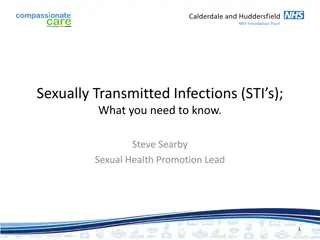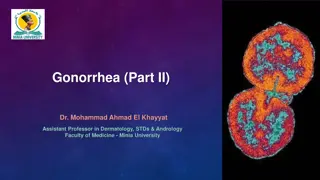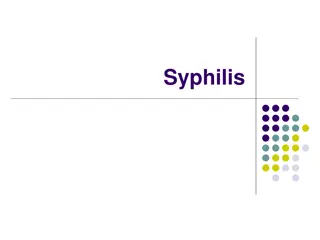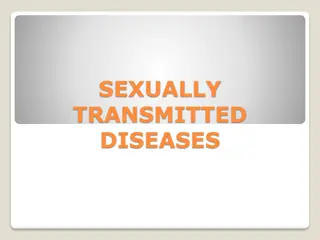Chlamydia and Syphilis: Common STDs to Know
Chlamydia and syphilis are common sexually transmitted infections that can have serious health consequences if left untreated. Chlamydia is often asymptomatic but can lead to complications like pelvic inflammatory disease in women. Syphilis presents with painless sores and can progress to affect the nervous system, heart, and brain. Both infections can be easily treated with antibiotics if detected early. It's crucial to be aware of the symptoms and risks associated with these STDs to protect your health.
Download Presentation

Please find below an Image/Link to download the presentation.
The content on the website is provided AS IS for your information and personal use only. It may not be sold, licensed, or shared on other websites without obtaining consent from the author.If you encounter any issues during the download, it is possible that the publisher has removed the file from their server.
You are allowed to download the files provided on this website for personal or commercial use, subject to the condition that they are used lawfully. All files are the property of their respective owners.
The content on the website is provided AS IS for your information and personal use only. It may not be sold, licensed, or shared on other websites without obtaining consent from the author.
E N D
Presentation Transcript
MOST COMMON STDS TO KNOW Unit 5 Ms. Bartkus
Shake, shake, shake, shake, uh shake it! Find three different people in the room and shake their hand. Y = Chlamydia H = Herpes After you shake their hand, write down their name on the back of your card. P = Pubic Lice V = HIV When you are done, please return to your seat. C = Used a condom A -Abstinence
CHLAMYDIA Extremely common sexually transmitted bacterial infection in the United States Chlamydia can infect the penis, vagina, cervix, anus, urethra, eye, or throat. Usually has NO symptoms or very mild symptoms after 5-10 days Known as the silent infection 70-95% of women do not know they have it 90% of men do not know they have it
CHLAMYDIA When symptoms are present, they may include: Abdominal pain Fever Swelling inside vagina and around anus Painful intercourse Abnormal, sometimes yellowish discharge that can have strong smell Urge to urinate more often Painful, burning urination Swollen testicles Pus or milky discharge from penis Itchy, bleeding anus in both men and women Can affect eye and throat -soreness, redness
CHLAMYDIA If untreated, it can cause: PID in women Epididymitis in men which can lead to sterility Reactive arthritis (pain/swelling in joints) which can disabling Passed through intercourse, and less often through oral sex Not passed through casual contact (sharing food or drinks, hugging, holding hands, coughing, sneezing, sharing towels, or sitting on toilet seats) Can be passed even without ejaculation Can be passed to fetus during pregnancy Easily cured with antibiotic
SYPHILIS Can infect the vagina, anus, urethra, or penis, as well as the lips and mouth. Often has no symptoms or has painless, contagious sores called chancres Sores can be mistaken for pimples, rashes or ingrown hairs Has different, more severe stages Untreated can lead to: Rash/sores on palms/feet, hair loss, fatigue, weight loss, fever Damage to nervous system, heart and brain. Can lead to death!
SYPHILIS Can be cured in EARLYstages easily with antibiotic Spread by: Intercourse Oral Sex Skin to skin sexual contact -when super contagious sores are present Spread to fetus
SYPHILIS Primary Stage Sore Secondary Stage sores/rash
GONORRHEA Very common for ages 15-24. Sometimes called the clap or the drip . Often no symptoms but can have: Abdominal pain Itching anus Yellow/green vaginal discharge, pus-like male discharge Painful, burning urination. more frequent urge to urinate Pain/swelling of vulva Fever/throwing up
GONORRHEA Can be cured with antibiotic If Left Untreated: Women: pregnancy complications, stillbirth, PID, infertility Men: Infertility caused by epididymitis, extremely painful scrotum and fevers Similar arthritis issues Spread through intercourse, oral sex and to fetus Not through casual contact
TRICHOMONIASIS Mostly just called trich Millions of people get it every year. It s caused by a parasite that spreads really easily during sex. The parasite is carried in sexual fluids, like semen, pre cum, and vaginal fluids. Trich is the MOST COMMON CURABLE STD
TRICHOMONIASIS Causes vaginitis and can infect the urethra Itchy, smelly discharge Frequent and painful urination. Also can cause blood in urine, swelling and pain during sex Not spread through casual contact Commonly spread through vaginal intercourse Can still easily be spread from getting infected fluid in penis or vulva
GENITAL HERPES Very common (1 in 6 Americans are infected) No cure!! Symptoms can be treated/managed outbreaks Condoms don t always cover infected area Can be spread with or without symptoms Most people get herpes when the other has no symptoms Virus can be released through the skin Painful sores, itching, discomfort, fevers Fluid in sores carry the virus and are very contagious
ORAL HERPES More than half of Americans have oral herpes Yes, oral herpes can be spread to the genitals Yes, genital herpes can be spread to the mouth
HUMAN PAPILLOMAVIRUS (HPV) Most commonly spread STI (viral infection) in United States Almost every person who has sex will get HPV at some point Can be spread with no symptoms. Most people do not know they have it. Over 100 different types/strands 40 effect genitals High risk HPV causes serious health issues and/or cancers (at least 12 strands) Low risk HPV can cause genital warts (2 strands) Can go away on its own, depending on strand
HUMAN PAPILLOMAVIRUS (HPV) Diseases caused by HPV can be prevented through vaccination Boys and girls ages 11-12 should get this Spread through intercourse, oral sex, and skin-to-skin contact Symptoms can appear years later, making it hard to know when you got it and who you've infected When diagnosed early enough, many health issues and cancers can be treated However, it is hard to diagnose
SKIN TO SKIN STDS Herpes (oral or genital) Pubic Lice Syphilis (when sores are present) Genital warts/HPV Scabies
WRAPPING IT UP FOR STDS 1.Extremely common bacterial STD and called Silent Infection =______________ 2.Syphilis can lead to nerve damage and _______ if left untreated. 3.Gonorrhea, syphilis and chlamydia can be spread to _______ in women while pregnant. 4.Chlamydia, gonorrhea and syphilis all have unwanted future health risks if left _________ 5. The most common curable STD: ______________. 6.There is no cure for _________ and some strands of HPV. 7.Most commonly spread sexually transmitted viral infection in US is _____________. 8.High risk HPV can cause ________________ and low risk can cause _________________.
KEY POINT! Most of the common STD s can be spread without symptoms showing (Maybe that s why they are so common?) so communicate and get tested!
HW Create your own STD venn diagram after we practice filling one out together. You may not use the exact same three! Gonorrhea Syphilis Chlamydia























